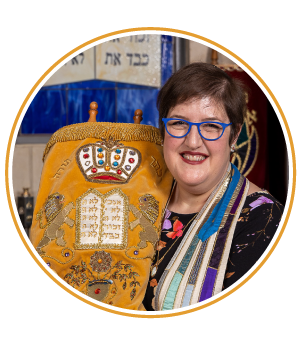 This Shabbat finds much of the Jewish people simultaneously preparing to greet Shabbat, and making plans and arrangements to clean chametz (specific grains forbidden during Passover) from our homes. Though the manual labor can be intense as we prepare our homes and our souls for Chag haAviv, the Spring Holy Day, we are also, I believe, readying our souls to experience freedom anew.
This Shabbat finds much of the Jewish people simultaneously preparing to greet Shabbat, and making plans and arrangements to clean chametz (specific grains forbidden during Passover) from our homes. Though the manual labor can be intense as we prepare our homes and our souls for Chag haAviv, the Spring Holy Day, we are also, I believe, readying our souls to experience freedom anew.
The removal of the chametz of our souls, the heavy things we carry emotionally and spiritually, is part of the way we can prepare for redemption. This cleansing cannot be accomplished by feather and candle alone. We need to realign ourselves with our values and ensure that the way we spend our time follows suit. Perhaps it is also asking for help, whether from loved ones or professionals to ensure that we are caring for our bodies, minds, and spirits.
In the midst of these Passover preparations, it is fascinating that we read Parashat Metzora this week. This portion speaks to a particular affliction called tzara’at. Though sometimes translated as leprosy, according to the The Torah: A Womens’ Commentary, tzara’at was likely more of a fungus or mold. Though described previously in Torah as an affliction that appears on a person, clothing, or vessels, we read in Leviticus 14 that tzaraat could also attack dwellings, homes.
This particular type of tzara’at, according to the Torah, is a plague on a house that is inflected by God. Though the Torah provides no explanation, we learn in Arachin 15b that Resh Lakish said tzara’at is afflicted because they were one who brings out an evil name, meaning a defamer, a person who speaks lashon hara, gossip. The Torah then describes a purification ritual, to be performed by a priest, to remove the plague and restore the home.
Rav Kook’s teaching about the two levels of purification can be instructive for us as we remove tzara’at and chametz (Gold from the Land of Israel: A new light on the weekly Torah portion from the writings of Rabbi Abraham Isaac HaKohen Kook by Rabbi Chanan Morrison). The first stage of purification, Rav Kook teaches, is to correct our faulty behavior, Rav Kook suggests using ritual immersion, mikveh, to affirm this step. In this season, perhaps this could be the ritual cleansing of our homes and our vessels for Passover.
The second step according to Rav Kook, is to restore or rehabilitate our relationship with the Holy One. In the Torah portion this is done through cleansing and plastering a home afflicted with tzara’at, followed by sacrifices by way of atonement. I would suggest that cleansing ourselves and our homes of chametz at this season is another way that we can take positive action to create opportunities for nearness to the Holy One.
May this Shabbat be one of rest and meaning, and one of preparation, too. For next week we will find ourselves marking Shabbat and Passover, celebrating our covenant with God and our liberation from oppression. May our preparations be meaningful.


The removal of the chametz of our souls, the heavy things we carry emotionally and spiritually, is part of the way we can prepare for redemption. This cleansing cannot be accomplished by feather and candle alone. We need to realign ourselves with our values and ensure that the way we spend our time follows suit. Perhaps it is also asking for help, whether from loved ones or professionals to ensure that we are caring for our bodies, minds, and spirits.
In the midst of these Passover preparations, it is fascinating that we read Parashat Metzora this week. This portion speaks to a particular affliction called tzara’at. Though sometimes translated as leprosy, according to the The Torah: A Womens’ Commentary, tzara’at was likely more of a fungus or mold. Though described previously in Torah as an affliction that appears on a person, clothing, or vessels, we read in Leviticus 14 that tzaraat could also attack dwellings, homes.
This particular type of tzara’at, according to the Torah, is a plague on a house that is inflected by God. Though the Torah provides no explanation, we learn in Arachin 15b that Resh Lakish said tzara’at is afflicted because they were one who brings out an evil name, meaning a defamer, a person who speaks lashon hara, gossip. The Torah then describes a purification ritual, to be performed by a priest, to remove the plague and restore the home.
Rav Kook’s teaching about the two levels of purification can be instructive for us as we remove tzara’at and chametz (Gold from the Land of Israel: A new light on the weekly Torah portion from the writings of Rabbi Abraham Isaac HaKohen Kook by Rabbi Chanan Morrison). The first stage of purification, Rav Kook teaches, is to correct our faulty behavior, Rav Kook suggests using ritual immersion, mikveh, to affirm this step. In this season, perhaps this could be the ritual cleansing of our homes and our vessels for Passover.
The second step according to Rav Kook, is to restore or rehabilitate our relationship with the Holy One. In the Torah portion this is done through cleansing and plastering a home afflicted with tzara’at, followed by sacrifices by way of atonement. I would suggest that cleansing ourselves and our homes of chametz at this season is another way that we can take positive action to create opportunities for nearness to the Holy One.
May this Shabbat be one of rest and meaning, and one of preparation, too. For next week we will find ourselves marking Shabbat and Passover, celebrating our covenant with God and our liberation from oppression. May our preparations be meaningful.